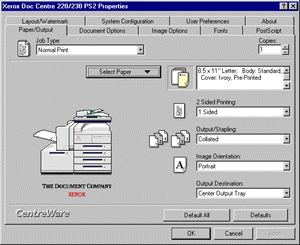 An
innnovative aspect of this driver was awarded this
US patent.
To download the driver, check out the Xerox CentreWare
site.
One of the most vexing problems in interaction
design involves the handling of constraints. One
user selection might prevent another selection
from functioning or produce unintended results.
For example: Selecting stapling as a finishing
option, while collate is turned off will produce
results that are most likely NOT what the user
wanted.
One way to handle this is to let the user make
any choices they want no matter how strange, then
warn them at the end. This approach works better
for expert users who may set options in an
unexpected order and occasionally want to
override constraints. This is not an ideal method
for infrequently used applications or features.
The approach I used in the CentreWare Print
Drivers was three fold.
First I tried to "design-out"
constraints. Some features were combined. For
example: "Collated", "Collated,
Stapled" and "Uncollated" all
appear in the same control. Combining some
features when practical is a way to make the
constraints implicit to the user.
Second, I let the application make some
decisions based on hierarchy and the user's
selection order. For example: When a user selects
transparencies, 2-sided printing is and stapling
automatically turned off.
Third, we developed a new form of context
sensitive help (patented).
If a feature is constrained because of a user
selection, an informational button conspicuously
appears next to the constrained control. If the
user clicks on this button, a message will appear
detailing the constraint. This was designed to be
unobtrusive, rather that popping a dialog up
whenever the user changed an affected selection.
As in the above example, if a user tried to turn
stapling on while transparencies were the
selected paper, that feature would be
unavailable. The user might wonder why and notice
the unusual info button right at the point of
need. Clicking this button will display the
message.
|